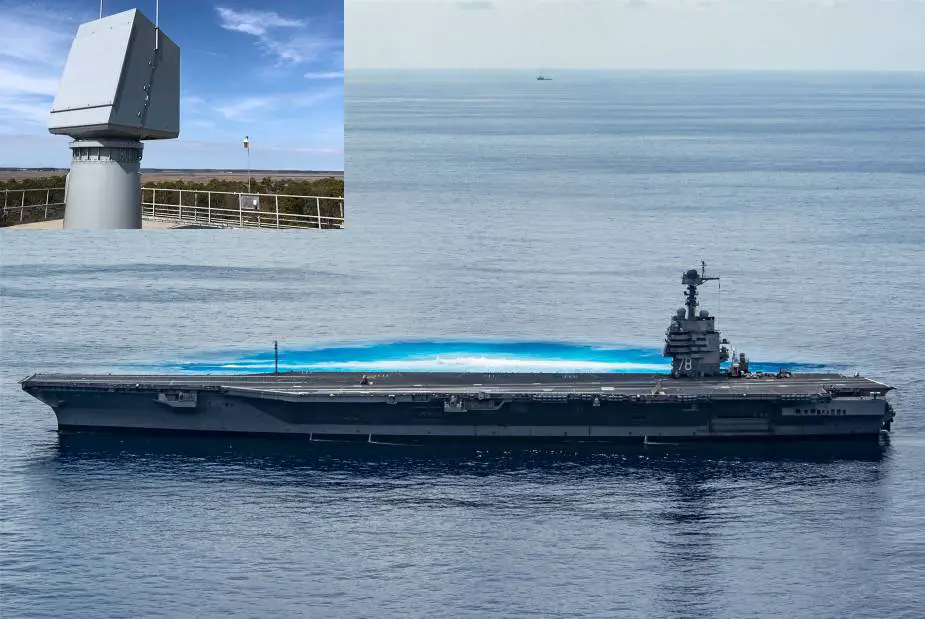The U.S. Navy and Raytheon Missiles & Defense, a Raytheon Technologies business, completed a series of tests on the Enterprise Air Surveillance Radar at the Navy’s Wallops Island Test Facility in Virginia. The tests validated the performance of EASR’s two variants: the SPY-6(V)2 rotating and SPY-6(V)3 fixed-face radars.
Follow Navy Recognition on Google News at this link
 The SPY-6(V)3 air defense radar will be fitted on the new U.S. Navy Ford-class aircraft carrier. (Picture source U.S. Navy)
The SPY-6(V)3 air defense radar will be fitted on the new U.S. Navy Ford-class aircraft carrier. (Picture source U.S. Navy)
The two EASR radars are the newest sensors in the SPY-6 family. SPY-6(V)2 and SPY-6(V)3 provide simultaneous anti-air and anti-surface warfare capabilities, including detecting and tracking uncrewed aerial vehicles, electronic protection, and air traffic control for aircraft carriers and amphibious warfare ships.
“EASR development is progressing rapidly because our engineers are applying the knowledge they’ve gained from the SPY-6 family,” said Kim Ernzen, vice president of Naval Power at Raytheon Missiles & Defense. “SPY-6’s common architecture saves time and money, and it streamlines training and logistics across software and hardware systems.”
The recent tests concentrated on anti-air warfare, air traffic control operations and power system modeling for SPY-6(V)2 and SPY-6(V)3 radars. EASR will replace single-function legacy radars, improving range and performance.
“EASR has proven it performs in high-clutter and dense tracking environments,” said Capt. Jason Hall, Above-Water Sensors program manager at the Navy’s Program Executive Office for Integrated Warfare Systems. “Teams continue to improve and enhance the system, and will integrate the radar with the combat management system using land-based testing.”
The AN/SPY-6(V)2 will be installed on amphibious assault ships and Nimitz class carriers. The AN/SPY-6(V)3 will be incorporated on Ford-class aircraft carriers and is compatible with frigates for international navies. AN/SPY-6(V)3 will be a centerpiece of the U.S. Navy’s new Constellation class frigates (FFG 62).
The AN/SPY6(V)3 is a 3-sided phased array fixed version of the EASR, each with 9 RMAs. It has the same capabilities as AN/SPY-6(V)2. Operating in S-band, it will serve as a Volume Search Radar complementing the AN/SPY-3 X-band radar on Gerald R. Ford-class aircraft carriers. It will be used to defend the ship against cruise missiles, anti-surface and anti-ship threats, and for jamming/clutter and electronic warfare
Raytheon Missiles & Defense and the U.S. Navy completed engineering and manufacturing developmental testing for EASR in March 2020. In July 2020, the Navy awarded the company a $126 million contract to produce four SPY-6(V)2 rotators and two SPY-6(V)3 fixed-faced radars.
The Gerald R. Ford (CVN-78) class carrier design is the successor to the Nimitz-class carrier design. The Ford-class design uses the basic Nimitz-class hull form but incorporates several improvements, including features permitting the ship to generate more aircraft sorties per day, more electrical power for supporting ship systems, and features permitting the ship to be operated by several hundred fewer sailors than a Nimitz-class ship.
The first ship in the class, USS Gerald R Ford (CVN 78), was delivered to the US Navy in May 2017 and commissioned in July 2017. On August 8, 2021, the U.S. Navy has announced that the USS Gerald R. Ford (CVN 78) successfully conducted a third explosive event off the coast of Jacksonville, FL, on 8 Aug., marking the completion of the ship’s Full Ship Shock Trials (FSST).



